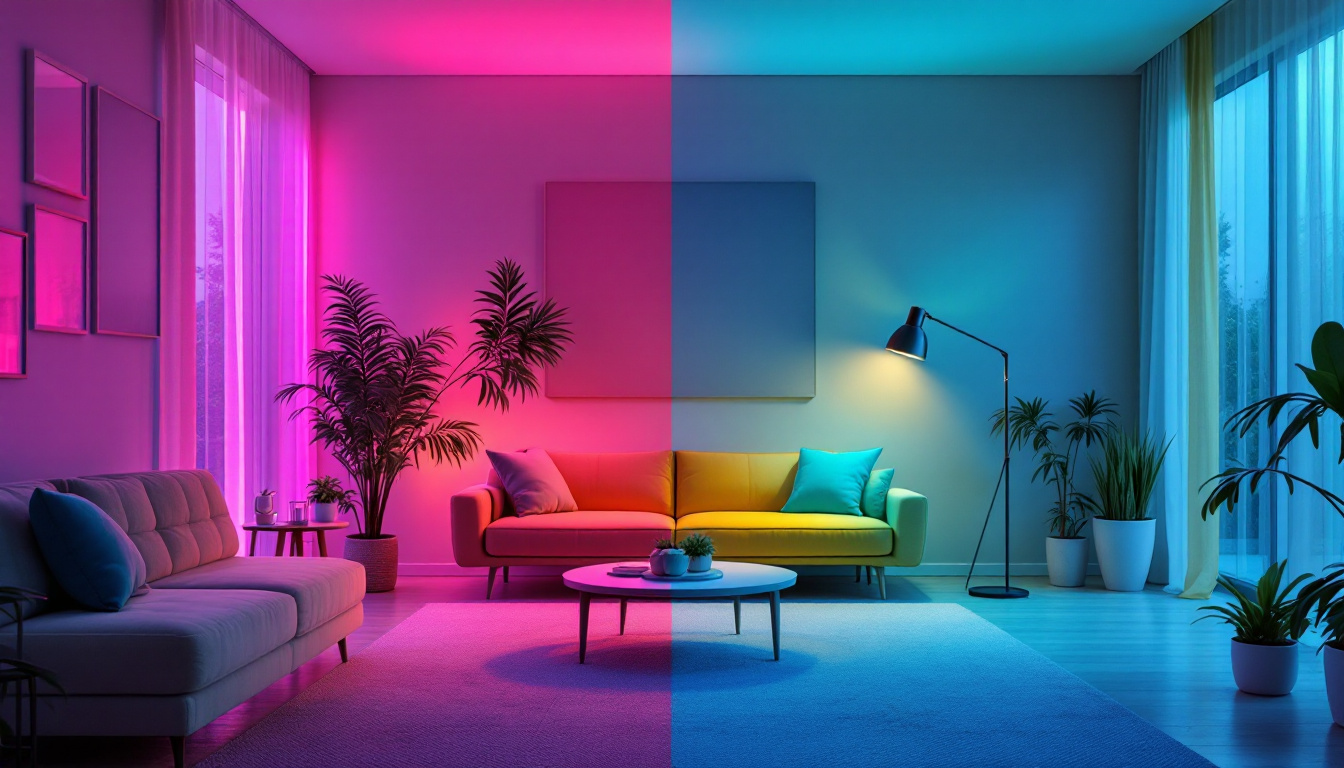
In the world of lighting, color temperature plays a crucial role in determining the ambiance and functionality of a space. For lighting professionals, understanding the differences between 4000K and 5000K lighting is essential for making informed decisions that meet the specific needs of clients. This article serves as a comprehensive checklist, providing insights into the characteristics, applications, and considerations of both color temperatures.
Color temperature, measured in Kelvin (K), indicates the warmth or coolness of a light source. Lower Kelvin values produce warmer, yellowish light, while higher values yield cooler, bluish light. The range of color temperatures can significantly affect the mood, productivity, and overall appearance of a space.
The Kelvin scale ranges from about 1000K to over 10000K, with common values for indoor lighting falling between 2700K and 6500K. At the lower end of the scale, around 2700K-3000K, light appears warm and inviting, ideal for residential settings. As the scale increases to 4000K and 5000K, the light becomes more neutral and cooler, suitable for various commercial and industrial applications. Beyond 6500K, the light takes on a daylight-like quality, often used in settings where accurate color rendering is essential, such as art studios or photography studios, where true colors must be represented accurately.
Choosing the right color temperature is not merely a matter of aesthetics; it can influence human behavior and well-being. Warmer lights can create a cozy atmosphere, making them perfect for homes and hospitality settings. In contrast, cooler lights can enhance focus and alertness, making them ideal for workspaces, retail environments, and healthcare facilities. Furthermore, the psychological effects of color temperature extend beyond mere comfort; research has shown that exposure to cooler light during the day can help regulate circadian rhythms, improving sleep quality and overall health. This is particularly important in workplaces where employees spend long hours indoors, as the right lighting can lead to increased productivity and reduced fatigue.
Additionally, the choice of color temperature can play a crucial role in design and architecture. For instance, in restaurants, a warmer light can encourage diners to linger and enjoy their meals, fostering a relaxed social environment. Conversely, in a gym or fitness center, cooler lighting can energize participants, motivating them to push through their workouts. lighting designers often take into account the intended use of a space, the time of day, and even the season when selecting the appropriate color temperature, ensuring that the lighting complements the overall design and enhances the user experience.
Both 4000K and 5000K lighting have their unique characteristics and applications. Understanding these differences can help lighting professionals select the appropriate option for their projects.
4000K lighting is often referred to as “neutral white.” It strikes a balance between warm and cool tones, providing a versatile solution for various environments. This color temperature is commonly used in offices, retail spaces, and educational institutions.
One of the key advantages of 4000K lighting is its ability to create an inviting atmosphere while still promoting productivity. It offers excellent color rendering, allowing for accurate color perception, which is essential in environments such as art studios and design offices. Furthermore, the neutral tone of 4000K lighting can help to reduce the harshness often associated with cooler light sources, making it a popular choice for spaces where people spend extended periods of time. This balance can lead to improved mood and comfort levels, fostering a more enjoyable work or learning environment.
5000K lighting, on the other hand, is known as “daylight” or “cool white.” This color temperature mimics natural daylight, providing a bright and vibrant illumination that can enhance focus and alertness. As a result, it is often favored in commercial settings such as warehouses, manufacturing facilities, and healthcare environments.
One of the primary benefits of 5000K lighting is its ability to reduce eye strain and fatigue, making it suitable for environments where individuals need to remain alert for extended periods. Additionally, it promotes a sense of cleanliness and clarity, which can be advantageous in spaces like hospitals and laboratories. The bright illumination of 5000K lighting can also help in improving visibility, which is crucial in safety-sensitive areas. Moreover, the crispness of this light temperature can enhance the appearance of products in retail settings, making colors appear more vibrant and details more pronounced, thereby influencing consumer decisions positively.
Understanding the applications of both 4000K and 5000K lighting can help lighting professionals make informed recommendations to their clients. Each color temperature has its strengths in different environments.
4000K lighting is ideal for settings that require a balance between warmth and brightness. Common applications include:
5000K lighting is well-suited for environments that prioritize alertness and clarity. Key applications include:
When deciding between 4000K and 5000K lighting, several factors should be considered to ensure the best outcome for the project.
Understanding the preferences and needs of clients is paramount. Some may prefer the warmth of 4000K lighting for its inviting nature, while others may prioritize the alertness and clarity provided by 5000K. Engaging in discussions with clients about their vision for the space can lead to a more satisfactory outcome.
The functionality of the space is another critical consideration. For example, a creative studio may thrive under 4000K lighting, while a manufacturing plant may require the brightness of 5000K. Assessing how the space will be used can guide the decision-making process.
Energy efficiency is an essential factor in modern lighting design. Both 4000K and 5000K lights are available in energy-efficient options, such as LED technology. Evaluating the long-term energy costs and initial investment can help clients make informed choices that align with their budgets and sustainability goals.
Lighting professionals must also consider the technical specifications and performance characteristics of the lighting options available. Understanding lumens, CRI (Color Rendering Index), and energy consumption can aid in making the right choice.
Lumens measure the amount of light emitted by a source. For both 4000K and 5000K lighting, selecting the appropriate lumen output is crucial to ensure adequate illumination for the intended space. Higher lumen outputs may be necessary in larger areas or spaces with high ceilings.
The Color Rendering Index (CRI) measures how accurately a light source displays colors compared to natural light. A higher CRI is essential in environments where color accuracy is critical, such as art studios or retail spaces. Both 4000K and 5000K lighting can achieve high CRI ratings, but it’s essential to verify the specifications of the specific products being considered.
Energy consumption and the lifespan of the lighting fixtures are vital considerations. LED options for both 4000K and 5000K lighting are available, offering lower energy consumption and longer lifespans compared to traditional incandescent or fluorescent bulbs. Evaluating the total cost of ownership, including energy savings and replacement costs, can provide valuable insights for clients.
The lighting industry is constantly evolving, with new trends and technologies emerging regularly. Staying informed about these trends can help lighting professionals provide innovative solutions to their clients.
Smart lighting technology is gaining traction, allowing for greater control and customization of lighting environments. Professionals can integrate 4000K and 5000K lighting into smart systems, enabling clients to adjust color temperatures and brightness levels based on their needs and preferences. This flexibility can enhance user experience and energy efficiency.
With an increasing emphasis on sustainability, many clients are seeking eco-friendly lighting solutions. Both 4000K and 5000K LED options are energy-efficient and have a lower environmental impact. Lighting professionals can educate clients on the benefits of sustainable lighting choices, aligning with their values and goals.
Biophilic design, which seeks to connect people with nature, is becoming more prevalent in lighting design. Utilizing 5000K lighting in spaces that mimic natural daylight can enhance well-being and productivity. Lighting professionals can explore ways to incorporate biophilic principles into their designs, creating healthier environments for occupants.
Choosing between 4000K and 5000K lighting is a critical decision for lighting professionals. By understanding the characteristics, applications, and considerations of each color temperature, professionals can make informed recommendations that meet the unique needs of their clients. Whether creating inviting office spaces with 4000K lighting or enhancing productivity in industrial settings with 5000K lighting, the right choice can significantly impact the functionality and ambiance of a space.
As the lighting industry continues to evolve, staying informed about trends and technological advancements will empower lighting professionals to deliver innovative and effective solutions. Ultimately, the goal is to create spaces that not only meet functional requirements but also enhance the quality of life for those who inhabit them.
Ready to elevate your lighting game with the best in 4000K and 5000K lighting solutions? Look no further than LumenWholesale, where we provide lighting professionals like you with top-quality, spec-grade lighting products at unbeatable wholesale prices. Our extensive selection is designed to meet the highest industry standards, ensuring you get reliable, high-performance lighting for every project. Plus, with free shipping on bulk orders, you can enjoy premium lighting at the best value — without hidden fees or compromises. Don’t settle for less; choose LumenWholesale for quality, affordability, and convenience. Wholesale Lighting at the Best Value is just a click away.

Discover the transformative impact of external motion sensor lights through compelling real-world success stories.

Discover the future of home illumination with “Led In The Wall.” This article explores innovative, energy-efficient lighting solutions that seamlessly integrate into your walls, offering both aesthetic appeal and cost savings.

Discover the frequent pitfalls lighting contractors encounter when installing solar driveway lamps.

Discover why LED flat panels are revolutionizing the lighting industry and why contractors should prioritize them.